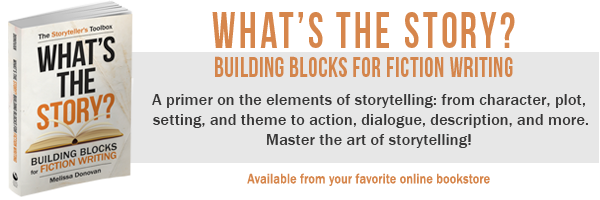Today’s post includes excerpts from What’s the Story? Building Blocks for Fiction Writing, chapter ten: “Literary Devices and Narrative Techniques.” Enjoy!
Writers use literary devices to convey or illustrate thoughts, ideas, and images or to strengthen their prose. Narrative techniques are a subset of literary devices that are specifically used in narrative writing. Both literary devices and narrative techniques occur naturally in writing but are also used intentionally. Learning about the many literary devices and narrative techniques that are available will add weight to your writer’s toolbox.
Narrative Techniques
As useful as literary devices are, most storytellers are more interested in narrative techniques. A narrative technique is a specific kind of literary device that is used in storytelling. Some narrative techniques are widely used and can be found in most stories, while others are common in certain genres. And some are best avoided. Narrative techniques should be used selectively, depending on what the story needs.
One of the most widely used narrative techniques is the inciting incident. This is a moment in a story where things change for the protagonist, marking the moment when the central conflict launches into action. In the Harry Potter series, it’s when Harry receives his first owl post inviting him to Hogwarts. In The Hunger Games, it’s when Katniss’s sister is selected as a tribute and Katniss volunteers in her place. The inciting incident is the moment when the Hero’s Journey truly begins, when the story kicks off after the setup has been established. It’s difficult to find a story that doesn’t contain an inciting incident.
A variety of narrative techniques are staples of genres. For example, a red herring is a literary technique used mostly in mystery stories. Readers are encouraged to solve the story’s mystery or puzzle, and a red herring is a clue that leads the audience in the wrong direction. Sometimes there are multiple red herrings that lead readers’ suspicions away from the true culprit.
There are also narrative techniques that can help storytellers avoid poor storytelling. These are techniques that may be used effectively on rare occasions but are usually hallmarks of weak plot points and amateur storytelling. Deus ex machina is a narrative technique in which characters are saved from a hopeless situation by a surprise character or unlikely event. Deus ex machina often pulls from the supernatural, such as when a god or magical creature saves a character, especially when this supernatural being has never been mentioned before in the story. In The Lord of the Rings, a Great Eagle conveniently shows up and rescues Frodo when he’s trapped on Mount Doom. In the Harry Potter series, a phoenix rescues Harry by bringing him a sword that was conveniently hidden in a hat. Both of these are examples of deus ex machina: the characters are trapped with no way out, and a surprising, somewhat unbelievable, and often super-powered entity shows up out of the blue to save the day. Because deus ex machina often feels too convenient and lacks believability, it’s best avoided if possible.
Narrative techniques are useful to writers in several ways, including troubleshooting. Some of the most common narrative techniques, like the inciting incident, function as milestones in almost every story. Authors can use these milestones to make sure their stories are on track. If the inciting incident occurs at the halfway mark of the story, an author knows there’s a problem and the story needs work, because inciting incidents should occur near the beginning. After all, it’s what kicks off the story.
Literary devices and narrative techniques are so common that many are inherent to storytelling. Novice storytellers may not even know that a story beat they’ve devised is actually a recognized narrative technique.
Anyone who wants to master the art of storytelling would be well served by studying narrative techniques and adding these tools to their toolboxes, as they are highly useful for every aspect of storytelling from devising a basic plot to polishing the finer points of the language.
Want to learn more about using literary devices and narrative techniques to strengthen your storytelling skills? Pick up a copy of What’s the Story? Building Blocks for Fiction Writing, which contains a full glossary of narrative techniques.






Thanks for posting this source.
You’re welcome!
I am in the process of writing my first draft for a screenplay and all theses nuggets help a lot!
Thank you for letting me know you found this article helpful! Comments like yours keep me going.
I enjoyed this, well thought. Thanks.
You’re welcome!